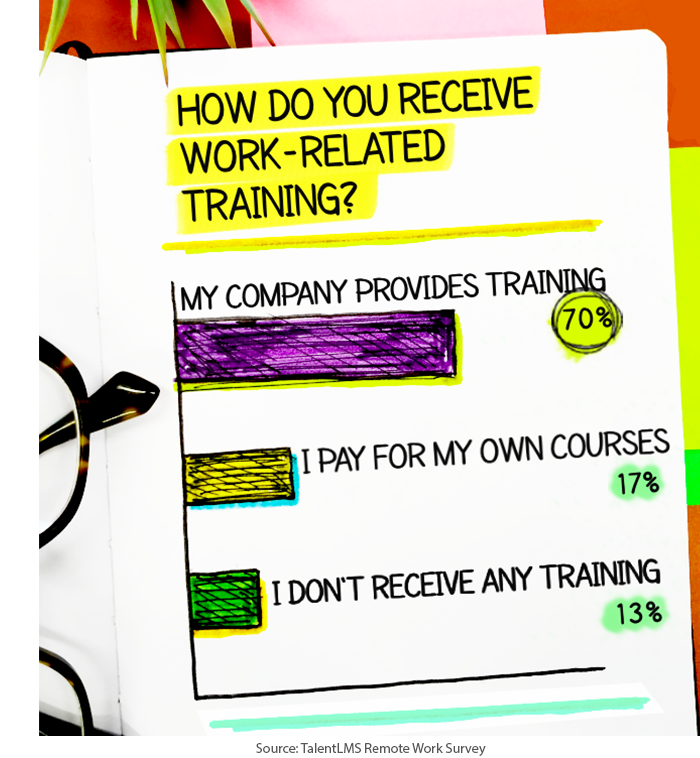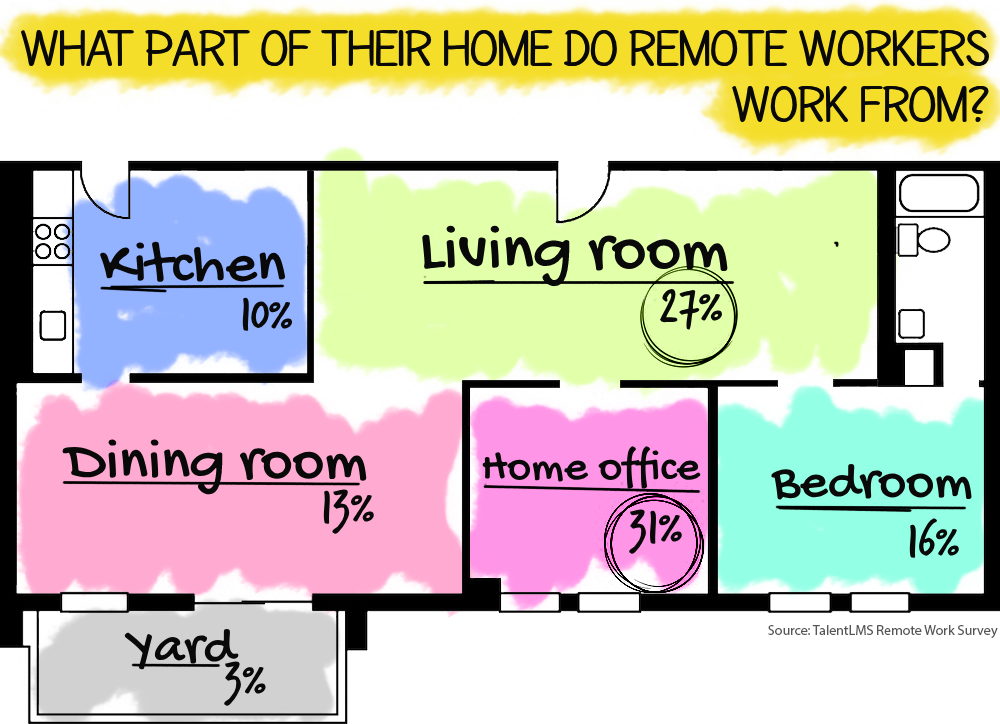The latest on all kinds of information, news, and resources that help you make working remotely better.

Too often we confuse remote work with working from home. The two aren’t the same. It isn’t just semantics, either. The words we use, and the way we talk about things is important. It communicates what we value, and using the wrong words can not only cause confusion, it can devalue your team members and the way they work.
Working from home is a temporary thing you do every once in a while.
It means that the work you usually would do in your office at your desk, you do from home for a day, or maybe two. In many companies, working from home is what you do on Thursdays because you don’t have any meetings, so you figure you’ll get caught up on the presentation you’re working on without the interruption of a colleague stopping by your desk.
Remote working is not just a circumstance, but rather a way of working.
If you work remotely, you don’t have a desk at your company’s office somewhere. Instead, you’re probably responsible for providing your own desk in your own workspace, usually somewhere in your own home.
When you work from home, you still use the tools and technology your company gave you, you just log on to your own internet connection. It’s OK if you don’t have everything you need at home, because you’ll be headed back to the office tomorrow anyway.
That’s not the case with remote work, and it requires a completely different set of tools and systems. Often, you have to create your own systems, and the place you work gets a lot more attention since it’s likely what your colleagues will see every time you log on to Zoom. Don’t underestimate the level of stress that goes into having the perfect background — or at least, one that isn’t cluttered with toys and laundry and pets. Or, as we call it at our home, real life.
It also means having a different set of skills. Setting your calendar and agenda for the day is different when you work remotely. Productivity and accountability look different as well. It’s time we start treating them that way.
X Misconceptions Related To Employee Tracking | Bhok Thompson, Greenprophet.com

Not too long ago, time tracking was time consuming.
While tracking time has been widely accepted as a viable way to improve productivity, filling out lengthy Excel sheets has commonly been viewed as an additional task.
As a result, the practice of time tracking has been known to face a lot of resistance in corporate scenarios.
However, things have changed. Today, there are specialized time tracking software that automate the part of time tracking that feels like a “task”.
Time Tracking Leads to Micromanagement
Many employees dread the idea of time tracking because they believe that it will lead to micromanagement. Now, there is no denying that there are many examples of micromanagers in almost all organizations. Be that as it may, if a manager isn’t someone who likes to micromanage their team, a time tracking software is not going to change that.
In fact, after the initial adoption period, employees can use their own historical time tracking data to justify a realistic workload and make realistic commitments to their managers.
Time Tracking Leads to Employee Burnout
This point is especially worrying to many nowadays when remote working is becoming popular. With blurring boundaries between homes and offices, the rigid office timings are also blurring and many professionals are reporting working well beyond their ‘normal’ working hours.
Contrary to popular belief, time tracking can help organisations and individuals solve this problem. With time tracking, employees can stay productive during the actual office hours and set boundaries that allow them to have personal time. At the same time, organisations will be able to ensure that their employees are giving their best during their official working hours.
Employees Will “Forget” Tracking Time
Nowadays, time tracking is automated to a large extent. Therefore, there’s not much left to ‘forget’.
Moreover, it is important for employers to communicate the individual benefits of time tracking to their employees. This way, they will be more motivated to keep track of their own time and the ‘forgetting’ incidents will be limited to a minimum.
Conclusion
The fact that there are so many misconceptions surrounding time tracking has been a significant deterrent in the adoption of this awesome productivity technique. However, we hope that this article will help you see the benefits of time tracking and implement it in your organization.
Checklist: How to effectively lead your remote employees | MYRECRUITMENT+, Smartcompany.com.au
How to lead remote employees effectively is a question on the minds of many SME owners. HR, managers, and executives control a workforce that exists mainly through virtual encounters, and must reassess operations and procedures to ensure efficiency is embedded in every process.
To assist you in your learning to lead a remote workforce, here’s a checklist for you to use as a guide in revealing where your strengths are and where you can improve.
Communication
- Do I implement a seamless communication system?
- Do my colleagues have someone else to communicate with if I’m unavailable?
- Even when I’m unavailable, do my colleagues know how to contact me in case of an emergency?
- Have I implemented scheduled hours? Why/why not?
- Have I confided in my colleagues and employees whether they are content with the current communication channels?
Collaboration
- Is there any tension between colleagues that I’m aware of?
- Do I receive regular feedback from colleagues/employees?
- Does the business provide the appropriate tools & resources for efficient collaboration?
- Have I put daily/weekly exercises in place for team bonding (thus more effective collaboration)?
Training
- Do I have standardized training material?
- Do I have a procedure in place to ensure the new hire receives training material specific to their department?
- Do I have a system in-place that allows full transparency so I can view who has completed their training, and who hasn’t?
- Do I have a system in-place that allows full transparency so I can view which employee is up-to-date in the latest training material, and which employee requires more training?
- Do we take advantage of an LMS?
Why is this checklist relevant?
Communication
It’s the key to running a remote workforce.
If employees have a question, they must receive answers within a suitable time frame. In order to overcome misunderstandings, you need to eliminate processes that encourage miscommunication.
A strategy for this? Ensure all employees have contact numbers and someone they can contact at any time (in the working day) for immediate assistance. You, as a leader, must act as the glue that keeps your team well bonded and functioning holistically.
Consider using tools that provide you with a 2-way bulk sms and email communication channel. This will allow you to quickly and efficiently provide stakeholders with recent updates.
Collaboration
Regardless of the company’s location (remote or in the office) teamwork is crucial for productivity. Employees that are motivated have higher job satisfaction, thus higher productivity.
So, how do you incorporate company culture to a workforce that is spread over states, and perhaps even the country?
Organize weekly meetings, perhaps a Monday morning (to talk about weekly goals), and Friday afternoon (to discuss achievements). Make it compulsory for everyone to attend. Whilst working from home allows flexibility, don’t forget that working your standard 9-5 job comes with requirements and responsibilities, so don’t be afraid of maintaining compulsory activities.
Training
The global pandemic has resulted in consistent updates regarding operational regulations and restrictions. In order to be compliant with these regulations, your employees must be up to date with training of current workplace procedures.
This includes hygiene practices, wellbeing exercises, operational restrictions, social distancing strategies etc. The consequences of being noncompliant (internally or externally) results in large fines, and an increased risk of contracting COVID-19.
Business owners should consider investing in a LMS system so new hires and existing employees receive identical training material. This promises consistency in knowledge and expectations.
Communicate, collaboration and training are closely entwined, and are the three main components to be considered when deciding a strategy to lead remote employees due to the dire consequences of overlooking their significance.
15 Ways to Maximize Your Productivity and Earnings | Kim Porter, Dollarsprout.com

Though you might use an eight-hour workday to benchmark your productivity, research suggests workers are only productive for about three hours during that time frame.
Here are 15 ways to boost your productivity and earning potential.
- Find your most productive hours.
To find your golden hours, listen to your body to get a sense of when you feel focused and motivated to tackle big projects. Plan your day so you’re doing the highest-priority work during your most productive hours, while routine tasks can be done when you don’t need as much concentration.
2. Figure out which office lifestyle is best for you.
Some people work best independently, while others thrive in an office setting. “In my experience, introverts really tend to enjoy working from home because they are energized by alone time,” says Alexis Haselberger, a productivity, time management, and leadership coach. “Extroverts tend to have a harder time working from home for the opposite reason; they are energized through time with others.”
3. Track and limit time spent on each task.
After a few months in the same role, you probably know how long it takes to complete your normal, routine tasks. When you need to schedule one, allot a reasonable amount of time and aim to get it done within that time frame.
4. Schedule your week.
Racheal Cook, business strategist and productivity expert, says she creates a weekly Google Calendar and first blocks out time for family, friends, and fun. She then blocks out major work tasks during defined hours to help create boundaries between work and her personal life. If you don’t make time for both, “then work can quickly take up every available moment in your week,” Cook says.
5. Give yourself periodic breaks.
Working at 100% capacity at all hours just isn’t sustainable. “If you don’t take regular breaks, you risk burnout,” Haselberger says.
6. Make time for personal and career development
Career development could include attending a training course for the next step in your career, watching a self-development seminar, or reading a book. Investing time in yourself might mean skipping billable client work now, but it boosts your earning potential over time. And focusing on personal goals can help you round out your work-life balance.
7. Avoid meetings if possible.
While meetings can be an efficient way to collectively brainstorm ideas and create solutions, more than $37 billion per year is spent on unproductive meetings, according to one estimate. But if you must have one, Haselberger offers these tips:
- Ensure every meeting has an owner. This person schedules the meeting, sets the agenda, and facilitates the discussion.
- Only include necessary attendees. Information can be disseminated to others on a need-to-know basis via other means.
- Always have an agenda. The owner sends the agenda to all attendees. It should state the objective, items for discussion, and any relevant materials to prepare attendees.
- Define the goal for the meeting. If you don’t know what you hope to accomplish, don’t schedule a meeting.
- Decision vs. discussion. Decide whether the purpose of the meeting is for decision-making or brainstorming and discussion.
8. Outsource or delegate work if you can.
Whether you’re running a business or part of a large project with co-workers, everyone has a strength and a role. Delegating or outsourcing work means “letting others do what they can do, so you can do what only you can do,” Marshall says.
9. Avoid time wasters.
Distractions can torpedo your workday. These come in the form of household chores, co-workers or kids, and emails and notifications. “Most people check email on average 37 times a day,” Haselberger says. “Every time we are interrupted or distracted, it takes, on average, 23 minutes to refocus.”
10. Create your own work processes.
Creating resources like processes, checklists, and pricing structures allows you to do the thinking and the work just once. Having the documentation will also help if you plan to grow your business in the future, Marshall says.
11. Automate tasks when possible.
Collaborating with project management tools, using accounting software, and scheduling social media posts are some other ways to automate tasks.
12. Exercise regularly.
Exercise does so much more than lower your blood pressure and help you fit into your jeans. In one study, employees who visited the gym said they were more productive, managed their time more effectively, and had smoother interactions with their colleagues. Exercise can also:
- Boost your concentration, memory, and creativity.
- Help you learn faster.
- Lower your stress levels.
13. Take time to rest and recharge.
Rest will look different for everyone, but here are a few ways to make it happen:
- Block off at least one day a week where no work is allowed.
- Practice self-care, which generally means sleeping enough, eating well, and exercising.
- Take a “mental health day” if you need it.
- Make time to visit friends and family. But don’t be afraid to say “no” to social visits if you’re feeling overwhelmed.
14. Get enough sleep.
According to the Centers for Disease Control and Prevention, about 1 in 3 adults don’t get enough sleep. What’s considered “enough” varies by age and person. But generally, adults should get between seven and nine hours of sleep each night, the CDC says. Here are some ways to help that happen:
- Save caffeine for the morning, and cut it from your afternoon and evening.
- Get into a consistent sleep schedule by going to sleep and waking up at the same time each day, including on weekends.
- Don’t use smartphones and other devices right before bedtime. They emit light that can mess with your circadian rhythm and ability to fall asleep.
- Avoid exercising and eating close to bedtime.
15. Make good food choices.
While any food generally fuels your body, some types of food are better at promoting productivity. Here are some general guidelines:
- Have healthy food choices available. In particular, fruits and vegetables have been shown to promote curiosity, motivation, and engagement. Nuts are also a healthy option.
- Don’t skip breakfast. A meal full of protein and complex carbohydrates gives your body the energy it needs to get through the day.
- Graze. Hunger can lead to lower levels of productivity, so have a steady stream of healthy snacks on hand to eat throughout the day.
Learning strategies to harness your focus and energy will help you use your time more meaningfully and efficiently.
This list serves as a starting point for taking care of yourself, setting goals, and squashing the time wasters that don’t contribute value to your work or personal life. You can start with one or combine a few into a more comprehensive strategy. Whether you’re freelancing or pushing for a raise at your full-time job, one thing is true: greater productivity equals more money in your pocket.













